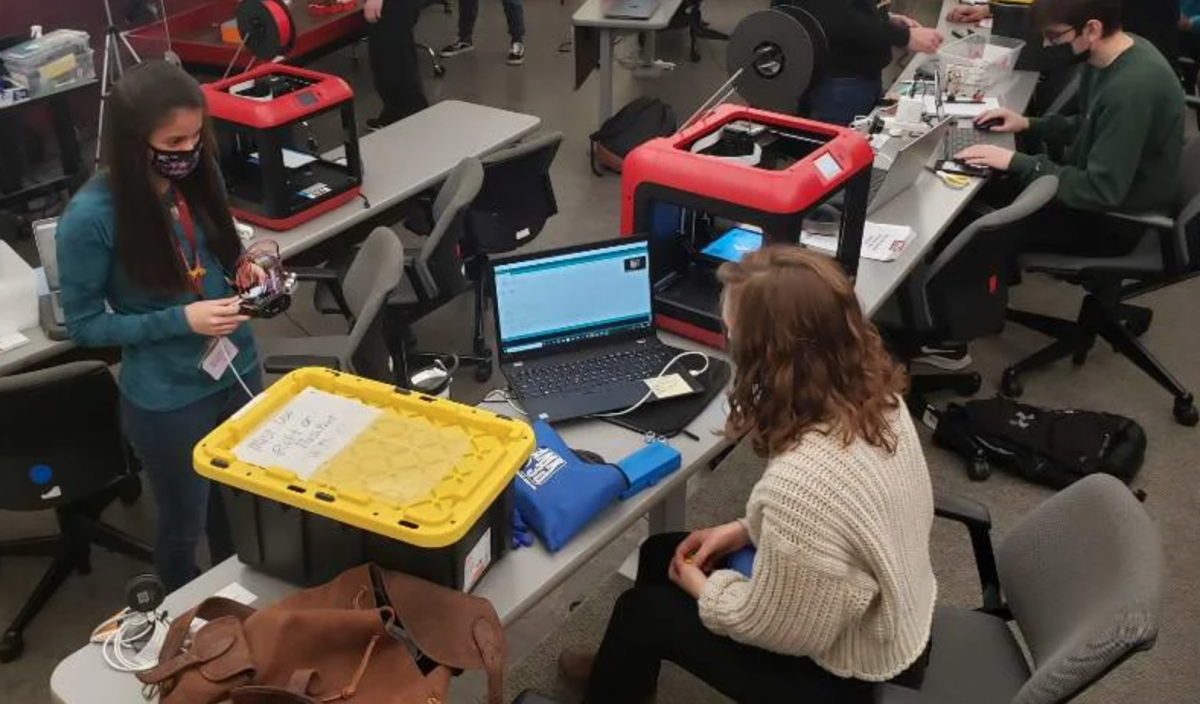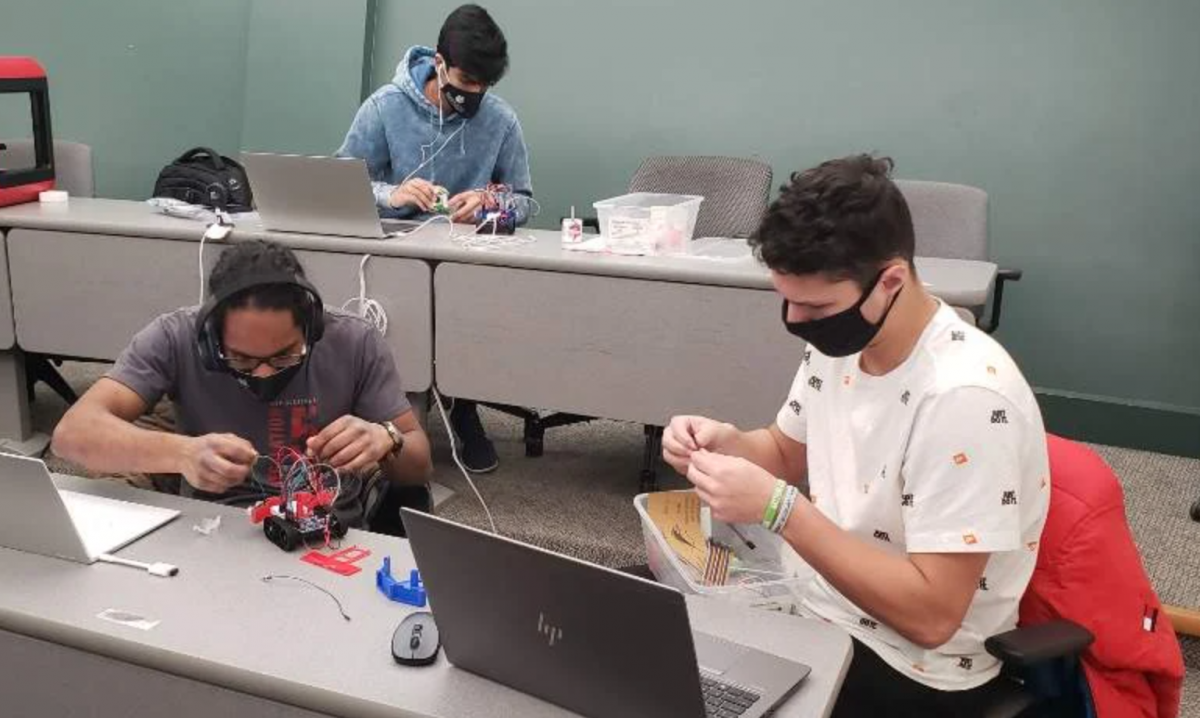Stevens’ Robot Challenge Invigorates the Experience of First-Year Students
New design lab encourages students to learn real-world skills in game-like environment
What if learning felt like play? What if solving challenging problems could simultaneously offer engaging exercises in creativity? The robot challenge, a new feature of the first-year student design labs at Stevens Institute of Technology, brings more play into the pedagogy. With the addition of the robot challenge to the design spine — Stevens’ core engineering curriculum — students experience the fun of immersive learning from day one.
The design spine is exclusive to Stevens’ curriculum
Collaboration and innovation are integral parts of the engineering design spine, an exciting feature unique to the curriculum at Stevens, which is comprised of a sequence of interdisciplinary design courses. The design spine ensures that students not only learn engineering principles and how to apply them; they also learn “soft” skills like creative thinking, problem solving, project management, communication and ethics that are increasingly important in the working world.
It is this combination of applied experience and soft skill development that is the heart of these eight hands-on design courses, which kick off with first-year design labs I and II. With one class each semester culminating in a two-semester senior capstone project, the design spine is the major vehicle for engineering students to develop competencies linked to courses in their chosen discipline. It also provides tangible context for the application of theories explored in the classroom.
"The design spine promotes solution-based thinking," said Kishore Pochiraju, associate dean for undergraduate studies. "Design is not about finding one solution from a formula, but searching and finding an optimal solution that satisfies all or most of the stakeholders.”
It is this comprehensive and engaging approach to engineering that provides career benefits for graduates because they have opportunities to think and innovate outside of the traditional course structures.
Leveling up with the robot challenge
Within the educational framework of the design labs, however, fun is a serious pursuit.
Enter the robot challenge, a brand new feature of the first-year student design labs that level up the first-year student experience at Stevens.
The robot challenge was incorporated into the first-year student design labs in the spring 2021 semester as part of continuous efforts to refresh and modernize the design spine.
Although students worked with robots as part of the design spine in the past, the previous robots were not required to do autonomous tasks. The changes in this course enable the students to take on challenges in real-world problems and hone their problem-solving skills.
“Students develop an autonomous robot that executes an arbitrary route plan autonomously on a model arena, which mimics Stevens campus,” explained Louis Oh, manager of the Schaefer School of Engineering and Science Center for Student Success/Lab. “In this challenge, the students are given a specific route to traverse on the simulated campus. The robots must execute the path, avoid the obstacles, and complete the loop. The autonomous robot arena is equipped with a GPS-like sensing system that provides the robot the location information. Students develop the robot, integrate the sensors, and develop the software for autonomous driving on arenas that are scale models of our campus.”
The technologies used and provided for this challenge are exciting and new, like sensing with programming languages such as LiDAR, communicating through MQTT protocol, and displaying OLED with a robust robot-chassis system.
“We also expect that the miniature campus buildings will bring an engaging yet educational class experience to the students,” Oh explained.
A thriving spirit of innovation amidst a global pandemic
Stevens is committed to exposing students to cutting-edge technology in order to encourage them to learn essential knowledge. That dedication was challenged in light of the COVID-19 pandemic.
Hands-on learning is a core component of the Stevens curriculum, which meant the institution needed to adapt in order to make sure the labs were also safe.
The lab was originally located in the basement of Edwin A. Stevens hall and needed larger and better ventilated spaces. To accommodate these requirements, it was moved to the second floor of Babbio, with four rooms allocated to it. It operates on a schedule in order to adhere to social distancing protocols, enabling all the students who are on campus to access the lab a minimum of 67% of the time.
In order to satisfy COVID-19 safety measures, the current design lab class only allows a maximum of 11 students in person at a time, even though there are 21 students in each section.
“We also divided the classes into two phases of 90 minutes each, where the students swapped from the work area (with tools and arena) to a waiting classroom. This way, all 21 students (if they are on campus) have access to the lab every week,” Oh said. “It took considerable preparation.”
Coming to campus during the pandemic is optional, so additional considerations were taken into account for virtual students. A special arena was created to access the lab remotely where they could test their code and view how the robots performed.
“Kits were sent to their homes so they can practice there,” Oh explained. “Students are able to perform teamwork successfully as the schedules for the entire semester — including who is physically in the lab and who is not — was decided before the first class began.”
“COVID-19 necessitated other features like remote access and installation of cameras so remote students can participate,” Oh added. “Several problems need to be overcome before the robot challenge can be successfully executed by students who do not have physical access to the arena.”
Overall, the design experience at Stevens prioritizes the development of students’ meaningful job skills, creating lasting impacts that will reverberate throughout their college career and beyond. The hands-on experience is what provides the most value, and the hybrid lab model ensured students were still able to receive that during the pandemic.
Developing hard and soft skills needed for entering the workforce
The new robot challenge provides exciting opportunities for students to use state of-the-art technologies to design and optimize a 3D robot platform with mounted sensors and a microcontroller; use pathfinding logic to navigate toward given coordinates; understand obstacle avoidance logic and modify it effectively, and debug and tune the code with logical thinking.
"What we are developing in students is the ability to be comfortable in the workplace," Pochiraju said. "Students are evaluating each other on their conclusions, they are challenging each other to grow, and that is the fundamental objective for the design spine."
He concludes that it is this focus on learning by experience that will benefit students as they move forward with internships, co-op placements, and, ultimately, when they join the workplace as employees. "Team dynamics is a part of the design spine experience where they are applying newly acquired skills,” Pochiraju said.
“The changes in this course enable the students to take on challenges in real-world problems and hone their problem-solving skills,” Oh added.
And having fun along the way? That’s a given.
Learn more about the undergraduate experience at Stevens:
Schaefer School of Engineering and Science undergradutate programs




